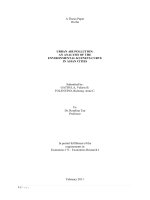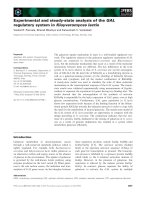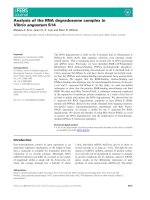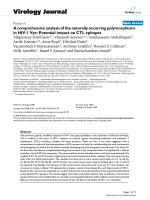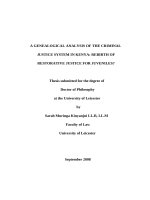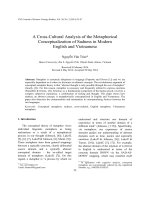Analysis of the multisubunit exocyst complex in schizosaccharomyces pombe
Bạn đang xem bản rút gọn của tài liệu. Xem và tải ngay bản đầy đủ của tài liệu tại đây (11.31 MB, 234 trang )
ANALYSIS OF THE MULTISUBUNIT EXOCYST
COMPLEX IN SCHIZOSACCHAROMYCES POMBE
WANG HONGYAN
A THESIS SUBMITTED
FOR THE DEGREE OF DOCTOR OF PHILOSOPHY
TEMASEK LIFE SCIENCES LABORATORY
NATIONAL UNIVERSITY OF SINGAPORE
2003
ii
ACKNOWLEDGEMENTS
I would like to express my sincere gratitude to my supervisor Dr. Mohan
Balasubramanian for excellent mentorship and unflagging support through the years.
It has been such a fortunate experience for me to have your guidance and
encouragement.
I would like to thank my thesis committee members Drs Suresh Jesuthasan, Jianhua
Liu, Uttam Surana and Alan Munn for the time and effort they have put in this project
and helpful suggestions and comments on my thesis projects.
I thank all past and present members of Balasubramanian and Munn laboratories,
especially Dr. Jianhua Liu’s for his guidance when I was new in the lab, Mr. Tang Xie
for the collaboration on the project and Drs Naweed Naqvi, Suniti Naqvi, Vicky
Boulton and Kelvin Wong for the helpful discussions and useful suggestions. I also
thank Drs Suniti Naqvi, Ventris D’Souza, and Jim Karagiannis for critical reading of
this thesis.
I thankfully acknowledge National Science and Technology Board / Agency for
Science, Technology & Research, Singapore (until July 2002) and subsequently
internal funds from the Temasek Life Sciences Laboratory, Singapore.
Finally, I would like to thank my husband Fengwei, without whose loving support and
encouragement this thesis would not be possible.
iii
TABLE OF CONTENTS
Page
Title page i
Acknowledgements ii
Table of contents iii
List of Figures ix
List of abbreviations xii
Summary xiii
CHAPTER I: Introduction 1
1.1 A general introduction of cytokinesis 1
1.1.1 Cytokinesis 1
1.1.2 Model organisms to study cytokinesis 1
1.1.2.1 Animal cells 2
1.1.2.2 Yeasts 3
1.1.2.3 Plants 5
1.1.3 The mechanisms of cytokinesis 6
1.1.3.1 The spatial control of cytokinesis 6
1.1.3.2 Composition and assembly of the actomyosin ring 6
1.1.3.3 New membrane/cell wall formation 7
1.1.3.4 Cell separation 7
1.2 Cytokinesis in Schizosaccharomyces pombe 8
1.2.1 The fission yeast cell cycle 8
1.2.1.1 The cell cycle and its regulation 8
1.2.1.2 Cytoskeletal rearrangement through the cell cycle 9
1.2.1.2.1 Microtubule cytoskeleton 10
1.2.1.2.2 Actin cytoskeleton 10
1.2.2 Mechanisms of cytokinesis in S. pombe 11
1.2.2.1 Positioning of the actomyosin ring in S. pombe 11
1.2.2.2 Assembly of the actomyosin ring in S. pombe 11
1.2.2.2.1 The role of myosin, light chains and a assembly
factor 12
1.2.2.2.2 A progenitor of the actomyosin ring 13
iv
1.2.2.3 A SIN pathway regulating septation 14
1.2.2.4 Cell separation in S. pombe 20
1.2.2.4.1 Transcription factors required for cell separation 20
1.2.2.4.2 Mid2p stabilizes the septin ring during cell separation
21
1.2.2.4.3 A few proteins are involved in cell separation by
unknown mechanisms 22
1.2.2.4.4 A glucanase Eng1p participates in cell
separation directly 22
1.3 Membrane dynamics during cytokinesis 23
1.3.1 An overview of secretory pathway 23
1.3.2 A requirement for membrane dynamics during cytokinesis 23
1.3.3 Exocytosis is utilized to achieve the surface expansion during
cytokinesis 24
1.4 The exocyst mediates tethering of vesicles at the plasma membrane 25
1.4.1 Exocyst is a multiprotein complex 25
1.4.2 A targeting factor Sec3p 26
1.4.3 A chain of interaction 26
1.4.4 A subcomplex of Sec15p-Sec10p 27
1.4.5 The Sec6/8 complex in mammalian cells 27
1.4.6 Rab GTPases 28
1.4.7 Fusion factors 28
1.5 Rho GTPases that are involved in cytokinesis 28
1.6 Aim and objectives of this thesis 29
1.7 Significance of this study 30
Chapter II Materials and Methods 31
2.1 Strains, reagents and genetic methods 31
2.1.1 Schizosaccharomyces pombe strains 31
2.1.2 Media and growth conditions 34
2.1.3 Plasmids 34
2.1.4 Enzymes and drugs used 35
2.2 Molecular methods and yeast methods 36
v
2.2.1 Standard recombinant DNA techniques were used in this study. 36
2.2.2 Nucleotide sequence determination 36
2.2.3 Sequence comparison 36
2.2.4 Transformation of E.coli by heat shock method 36
2.2.5 Southern blot 37
2.2.6 LiAc transformation of S. pombe 38
2.2.7 Extraction of S. pombe genomic DNA 39
2.2.8 Plasmid rescue from S. pombe 39
2.2.9 Spore germination 40
2.2.10 Synchronization by Nitrogen Starvation 41
2.3 Isolation of yeast genes, construction deletion mutants and epitope
tagging of genes 41
2.3.1 Identification of sec6
+
, sec8
+
, sec10
+
, sec15
+
and exo70
+
41
2.3.2 Construction of deletion mutants for exocyst components 42
2.3.3 Epitope tagging and regulated expression of the exocyst gene
Products 43
2.3.4 Generation of mutations in rho3 44
2.3.5 GFP tagging of Rho3p 45
2.4 Protein and immunological methods 45
2.4.1 Extraction of protein from S. pombe by a bead beater 46
2.4.2 Preparation of protein lysate from S. pombe (NaOH lysis methods) 46
2.4.3 Immunoprecipitation 47
2.4.4 Protein electrophoresis, immunoblotting and detection 47
2.4.5 Stripping and reprobing the immunoblot 48
2.4.6 Measurement of acid phosphatase secretion 49
2.5 Microscopy 49
2.5.1 DNA, F-actin and cell wall staining 49
2.5.2 Immunofluorescence staining 50
2.5.3 Electron Microscopy to visualize the membrane structures 51
2.5.4 Confocal microscopy 52
Chapter III Characterization of the Exocyst Complex in S. pombe 53
3.1 Introduction 53
vi
3.2 Results 55
3.2.1. Linkage analysis of sec8 gene 55
3.2.2 Sec8p is related to proteins from other organisms 55
3.2.3 Phenotype of sec8-1 at the restrictive temperature 56
3.2.4 sec8-1 is defective in cell separation, but not in other aspects of
cytokinesis 57
3.2.5 Identification of sec6
+
, sec10
+
, sec15
+
and exo70
+
sequences
from the S. pombe genome database 58
3.2.6 The exocyst components interact in vivo 58
3.2.6.1 Sec8p associates with Sec6p, Sec8p, and Exo70p 58
3.2.6.2 Sec6p, Sec10p and Exo70p associate with each other 60
3.2.7 Sec6p, Sec8p, Sec10p and Exo70p localize to the division site
in S. pombe 61
3.2.7.1 The exocyst components are localized to the division site
as well as cell tip(s) 61
3.2.7.2 The exocyst ring does not undergo constriction 62
3.2.7.3 The exocyst components co-localize in fission yeast 62
3.2.7.4 The exocyst components is localized as two-ring rather
than two-disc structure 63
3.2.8 The localization of the exocyst components requires F-actin but
not secretion 63
3.2.8.1 The medial localization of the exocyst is dependent on
intact F-actin structures 64
3.2.8.2 The medial localization of the exocyst does not require
exocytosis 65
3.2.9 Phenotype of exocyst-null mutants 67
3.2.9.1 Null mutants of all exocyst components show a cell
separation phenotype 67
3.2.9.2 Sec8p is not detected in sec8-null mutant 68
3.2.10 The phenotype of sec8 shut off 69
3.2.11 The exocyst is involved in exocytosis 70
3.2.11.1 sec8-1 mutant cells accumulate secretory vesicles 70
3.2.11.2 sec8 shut off mutant accumulate secretory vesicles 71
vii
3.2.12 sec8-1 secrets less activity of acid phosphatase 71
3.2.13 The exocyst does not seem to interact with septins in S. pombe 72
3.3 Discussion 105
3.3.1 An exocyst complex in the fission yeast Schizosaccharomyces
Pombe 105
3.3.2 The S. pombe exocyst localizes to regions of active secretion 106
3.3.3 The S. pombe exocyst is critical for cell separation 108
Chapter IV Characterization of Rho3p in S. pombe 111
4.1 Introduction 111
4.2 Results 112
4.2.1 Rho3p encodes a small ras superfamily GTPase 112
4.2.2 Overexpression of Rho3p suppresses phenotypes associated
with sec8-1 112
4.2.3 rho3 is unable to suppress sec8 null mutant 114
4.2.4 rho3 null mutant is defective in cell separation 114
4.2.5 rho3
∆
is synthetically lethal with sec8-1 and exo70
∆
115
4.2.5.1 rho3
∆
is synthetically lethal with sec8-1 115
4.2.5.2 rho3
∆
interacts genetically with exo70
∆
116
4.2.6 Phenotypes of dominant rho3 mutations 117
4.2.6.1 The dominant-active form of Rho3p 117
4.2.6.2 The dominant-inactive form of Rho3p 118
4.2.7 The localization of exocyst proteins is independent of Rho3p 118
4.2.8 Localization of Rho3p 119
4.2.8.1 GFP-Rho3 expressed from native promoter did not show
localization 119
4.2.8.2 GFP-Rho3p localizes to the division site 119
4.2.8.3 Rho3p localization partially requires functional exocyst 119
4.2.9 Rho3p is involved in vesicle transport 120
4.2.9.1 rho3
∆
cells accumulate a large number of secretory
vesicles 120
4.2.9.2 rho3
∆
cells secrete less activity of acid phosphatase
at 36°C 121
viii
4.3 Discussion 135
4.3.1 Rho3p is a protein of Ras superfamily of small GTPase 135
4.3.2 Rho3p is a regulator of cell separation and exocytosis in S. pombe 137
Chapter V General Discussion 139
References 145
ix
LIST OF FIGURES
Figures Pages
Figure 1.1.2 A comparison of mechanisms of cytokinesis among
animals, yeasts and plants. 15
Figure 1.2.1.1 The mitotic cell cycle of the Schizosaccharomyces
pombe.16
Figure 1.2.1.2 Cytoskeletal reorganization and cell wall construction
during fission yeast cell cycle. 17
Figure 1.2.2.3 The Septation Initiation Network (SIN) cascade. 18
Figure 3.2.1 mut2-1 is linked to sec8 locus. 74
Figure 3.2.2 Alignment of S. pombe Sec8p with its related protein
from budding yeast, rat and human. 75
Figure 3.2.3 Phenotype of sec8-1 (mut2-1) cells. 76
Figure 3.2.4 sec8-1 is not defective in polarized cell growth in a
synchronous culture. 77
Figure 3.2.5-1 Alignment of S. pombe Sec6p with its homologous
proteins from budding yeast, rat and human. 78
Figure 3.2.5-2 Alignment of S. pombe Sec10p with its homologous
proteins from budding yeast, rat and human. 79
Figure 3.2.5-3 Alignment of S. pombe Sec15p with its homologous
proteins from budding yeast, rat and human. 80
Figure 3.2.5-4 Alignment of S. pombe Exo70p with its homologous
proteins from budding yeast, fly and rat. 81
Figure 3.2.6.1 Sec6p, Sec8p, Sec10p and Exo70p associate in vivo.82
Figure 3.2.6.2 Sec6p, Sec10p and Exo70p associate with each other
in vivo. 83
Figure 3.2.7.1-1 Localization of the S. pombe Sec6p in wild-type cells. 84
Figure 3.2.7.1-2 Localization of Sec6p in cdc25-22 cells. 85
Figure 3.2.7.2 The exocyst ring does not constrict like that observed for
the actomyosin ring. 86
Figure 3.2.7.3 Colocalization of the exocyst proteins. 87
Figure 3.2.7.4 The exocyst localizes to two-ring structure rather than
two discs. 88
x
Fig 3.2.8.1-1 The assembly of Sec6p ring at the division site is
dependent on F-actin. 89
Figure 3.2.8.1-2 The assembly of Sec10p ring requires intact F-actin
structures. 90
Figure 3.2.8.1-3 The localization of Sec6p is dependent on functional Cdc8p. 91
Figure 3.2.8.1-4 The localization of Sec6p is dependent on functional Cdc12p. 92
Figure 3.2.8.1-5 The localization of Sec6p requires functional Cdc15p. 93
Figure 3.2.8.2-1 The medial localization of Sec6p does not require exocytosis. 94
Figure 3.2.8.2-2 Sec6p can localize to the division site in sec8-1 cells. 95
Figure 3.2.8.2-3 The localization of Sec10-GFP is independent of secretion. 96
Figure 3.2.8.2-4 Sec10 localizes to the division site in sec8-1 cells. 95
Figure 3.2.9.1 The phenotype of the exocyst null mutants. 97
Figure 3.2.9.2 The maternal Sec8p is not detected in germinating sec8∆ cells. 99
Figure 3.2.10 Shutting of Sec8p expression causes defects in cell separation. 99
Figure 3.2.11.1-1 Ultra-structural analysis of wild-type S. pombe cells. 100
Figure 3.2.11.1-2 Ultra-structural analysis of sec8-1 cells. 101
Figure 3.2.11.2 Electron microscopic analysis of sec8 shut-off cells. 102
Figure 3.2.12 sec8-1 displays lower activity of secreted acid phosphatase. 103
Figure 3.2.13 Co-localization of the exocyst with septins in S. pombe. 104
Figure 4.2.1 The alignment of S. pombe Rho3p with its related protein
from E. gossypii and S. cerevisiae. 122
Figure 4.2.2 Overexpression of Rho3p suppresses all deleterious
phenotypes associated with sec8-1. 123
Figure 4.2.3 Overexpression of Rho3p is unable to suppress a sec8
∆
strain. 125
Figure 4.2.4 A rho3
∆
mutant is defective in cell separation at the
restrictive temperature. 126
Figure 4.2.5.1 sec8-1 is synthetically lethal with rho3 deletion mutant. 127
Figure 4.2.5.2 sec8 interacts genetically with exo70. 128
Figure 4.2.6 Two mutant forms of Rho3p. 129
Figure 4.2.6.1 The phenotype of a dominant-active form of Rho3p. 130
Figure 4.2.6.2 The phenotype of a dominant-inactive form of Rho3p. 130
Figure 4.2.7 Sec8-GFP localization is Rho3p independent. 131
Figure 4.2.8.2 GFP-Rho3p expressed under nmt1 promoter localizes to
xi
the division site. 132
Figure 4.2.8.3 GFP-Rho3p localization is partially dependent on
functional Sec8p. 132
Figure 4.2.9.1 Rho3p is required for a late stage of secretory pathway. 133
Figure 4.2.9.2 rho3
∆
cells secrets lowered activity levels of acid
phosphatase. 134
xii
ABBREVIATIONS
aa Amino acids
bp Base pair
BSA Bovine serum albumin
cDNA complementary DNA
DAPI 4’6,-diamidino-2-phenylindole
DMSO Dimethyl sulfoxide
dNTPs deoxy Nucleotide triphosphates
DTT Dithiothreitol
EDTA Ethylenediamine tetra acetic acid
GFP Green fluorescence protein
IPTG isopropyl—D-thiogalactopyranoside
kb Kilobase pairs
kDa kilo Daltons
Leu Leucine
PBS Phosphate buffered saline
PCR Polymerase chain reaction
PEG Polyethylene glycol
PMSF Phenylmethylsulfonylfluoride
rpm revolutions per minute
SDS Sodium dodecyl sulphate
SDS-PAGE Sodium dodecyl sulphate-polyacrylamide gel electrophoresis
TCA Trichloroacetic acid
TE Tris/EDTA
TEMED N,N,N’ N’ –tertamethylenediamine
Tris Tris(hydroxymethyl)aminomethane
ts Temperature sensitive
Ura Uracil
xiii
SUMMARY
Cytokinesis is the final stage of the cell division cycle in which one cell is physically
divided to form two daughter cells. In recent years, the fission yeast
Schizosaccharomyces pombe has emerged as an attractive model organism for the
study of cytokinesis. It divides using an actomyosin ring whose constriction may
generate the force necessary to pinch off two daughter cells. The constriction of the
actomyosin ring is coordinated with the centripetal deposition of a multi-layered
division septum, composed of one layer of primary septum adjacent with two layers of
secondary septa. Finally, degradation of the inner layer of the division septum,
primary septum, results in the liberation of daughter cells. While numerous studies
have focused on actomyosin ring and division septum assembly, little information is
available on the mechanism of cell separation.
In chapter III of this study, the essential role of a multi-protein complex, exocyst, in
cell separation is described. These exocyst proteins localize to regions of active
exocytosis: at the growing ends of interphase cells and in the medial region of cells
undergoing cytokinesis in an F-actin-dependent and secretion-independent manner.
Using biochemical means, I show that Sec6p, Sec8p, Sec10p, and Exo70p interact
physically with each other, indicating that these proteins form a complex in vivo in S.
pombe. sec8-1, a temperature-sensitive mutant deficient in a component of the exocyst
complex, is defective in cell separation, but not in other aspects of cytokinesis at
restrictive temperature. Analysis of a number of mutations in various exocyst
components has established that these components are all essential for cell viability.
Interestingly, all exocyst mutants analyzed appear to be able to elongate and assemble
division septa, but are defective for cell separation. I therefore propose that the fission
xiv
yeast exocyst may be involved in targeting of enzymes responsible for septum
cleavage. It is possible that cell elongation and division septum assembly can continue
with minimal levels of exocyst function. Interestingly, sec8-1 mutants accumulate
~100 nm vesicles in the cytoplasm, indicative of a defect in post-Golgi vesicle
trafficking to the plasma membrane. In sec8 shut-off cells, a similar accumulation of
putative vesicles was also observed, suggesting that Sec8p, and by in extrapolation, the
fission yeast exocyst, is likely to be involved in exocytosis.
Chapter IV describes the analysis of the role of Rho3p, a member of the Rho family of
small GTPase, in cell separation and exocytosis. The rho3 gene, which encodes a Rho
family GTPase, was isolated as a high-copy suppressor of sec8-1, the exocyst
component mutation (Wang et al., 2002). Overexpression of Rho3p suppresses cell
separation and exocytic defects of sec8-1, suggesting a functional correlation of Rho3p
with Sec8p. Overproduction of Rho3p also suppresses the temperature-sensitive
growth phenotype observed in cells lacking Exo70p, another conserved component of
the S. pombe exocyst complex. Cells deleted for rho3 arrest at higher growth
temperatures with two or more nuclei and uncleaved division septa between pairs of
nuclei, indicative of a defect in cell separation. rho3
∆
cells, like sec8-1 cells,
accumulate ~100 nm vesicle-like structures in the cytoplasm, suggesting that Rho3p
may play a role in exocytosis, similar to the exocyst complex. Taken together, these
results suggest the possibility that S. pombe Rho3p regulates cell separation and
exocytosis by modulation of exocyst function.
Key words: S. pombe, cytokinesis, exocytosis, exocyst complex, Rho3p
1
Chapter I Introduction
1.1 A general introduction to cytokinesis
1.1.1 Cytokinesis
Cytokinesis is one of the late events of the cell cycle, which physically partitions
segregated chromosomes, organelles and cytoplasm, by building membranous barriers
between the post mitotic nuclei leading ultimately to the generation of two independent
daughter cells (recently reviewed by Guertin et al., 2000). In a number of eukaryotes,
including yeast, nematode and mouse, cytokinesis is achieved through the use of an
actomyosin-based contractile ring (Hales et al., 1999). In the majority of organisms
the actomyosin ring is formed following entry into mitosis and subsequently constricts
following mitotic exit. This constriction may generate the forces required to
invaginate membranes at the cleavage furrow (Schroeder, 1990). In coordination with
actomyosin ring constriction new membranes and cell wall (in some organisms)
between the post mitotic nuclei are assembled to allow daughter cells to become fully
independent of each other (Bowerman and Severson, 1999; Smith, 1999). Finally, the
daughter cells are liberated during abscission /cell separation (Glotzer, 1997; Johnson
et al., 1982).
1.1.2 Model organisms used to study cytokinesis
Studies of cytokinesis in animals, yeasts, plants and bacteria have greatly contributed
to the understanding of this event. Cytokinesis is achieved using different mechanisms
in different organisms (Fig 1.1.2). In animal cells cytokinesis is dependent on the
assembly of an actomyosin ring (reviewed by Hales et al., 1999) followed by the
addition of new membranes at the site of division concurrently with ring constriction
(reviewed by Bowerman and Severson, 1999). In plant cells cytokinesis appears to not
2
involve the function of an actomyosin ring, but is achieved through the assembly of
new cell wall and membranes at the division site (reviewed by Staehelin and Hepler,
1996). Yeast and fungal cells accomplish cytokinesis using three structures: the
actomyosin ring, the division septum (a structure made up of cell wall polymers) and
new membranes (reviewed by Guertin et al., 2002). Whereas events such as DNA
synthesis and mitosis have displayed remarkable conservation among diverse
eukaryotes, cytokinesis presents a unique challenge. A combination of the actomyosin
dependent/independent and cell wall requiring/non-requiring mechanisms participate
in cytokinesis in different organisms. Therefore, it becomes important to study
cytokinesis using various experimental systems to gain a relatively complete
understanding of the mechanisms regulating this cellular event.
1.1.2.1 Animal cells
Animals including Xenopus laevis, Drosophila melanogaster and Caenorhabditis
elegans have been used as model systems to study cytokinesis. Animal cells choose
the site of division by using either overlapping astral microtubules (Rappaport model;
Devore et al., 1989) or midzone microtubules (antiparallel microtubules appearing
from anaphase to cytokinesis; Wheatley and Wang, 1996) of the mitotic spindle. At
the site of division, an equatorial actomyosin ring composed of actin, myosin
(Schroeder, 1990) and a number of other proteins, is assembled in late anaphase. Most
components of the actomyosin ring including myosin, anillin, PSTPIP, and septins
appear to be conserved between yeast and animals (reviewed by Hales et al., 1999).
Membranous barriers between daughter cells are formed during furrow ingression. In
sea urchin, C. elegans, Xenopus and Drosophila, new membrane addition at the
cleavage furrow is required for cytokinesis (Collas et al., 1996; Jantsch-Plunger and
3
Glotzer, 1999; Lecuit and Wieschaus, 2000; Loncar and Singer, 1995; Roberts et al.,
1992). Furrow ingression terminates when it reaches the spindle midzone and two
daughter cells remain connected by a cytoplasmic bridge (McIntosh and Landis, 1971).
Finally, the remnants of the contractile ring and spindle midzone are disassembled, the
cytoplasmic bridge is broken and the plasma membrane is sealed in the process of
completion/abscission (McIntosh and Landis, 1971).
1.1.2.2 Yeasts
The fission yeast, S. pombe, determines the position of the division site by the position
of the interphase nucleus (Chang et al., 1996). In early mitosis, the actomyosin ring is
assembled at the medial region of the cell and undergoes constriction at the end of
mitosis (Guertin et al., 2002). Concurrent with actomyosin ring constriction is the
deposition of a division septum that is composed of cell wall material at the division
site (Gould and Simanis, 1997). The division septum is a three-layered structure and is
composed of an inner primary septum and two flanking layers of secondary septa
(Gould and Simanis, 1997). The primary septum is composed of both linear and
branched 1,3-β-glucans, whereas secondary septa is composed of linear 1,3-α-glucan,
1, 6-β-glucans and branched 1,3-β-glucans (Duffus et al., 1984; Humbel et al., 2001).
Finally, cell separation occurs by the degradation of the primary septum by 1,3-α- and
1,3-β- glucanases that liberate the two daughter cells (Johnson et al., 1982). This is an
event unique to unicellular fungal cells surrounded by rigid cell walls. Both the
actomyosin ring and the division septum are essential for cytokinesis in S. pombe. The
ease with which fission yeast can be manipulated experimentally, taken together with
the similarities in the process of cytokinesis in fission yeast and animal cells, makes it
4
an attractive model to study the dynamics and assembly of the actomyosin ring as well
as formation of new membrane/cell wall during cytokinesis.
In the budding yeast, Saccharomyces cerevisiae, the division plane is under the control
of mating type loci and is specified by the formation of a septin ring at the cell cortex.
Mating type a and α haploid cells assemble axially placed buds, while a/α diploid cells
assemble bipolar buds (Chant and Pringle, 1995). A new bud grows upwards from the
position of the septin ring which becomes the future site of cell division. The
actomyosin ring is assembled in two temporally distinct stages. The Myo1p ring forms
early in the cell cycle at the G1/S transition, and the actin ring assembles in late
mitosis (Bi et al., 1998; Lippincott and Li, 1998). Cells lacking Myo1p are viable but
do display cytokinetic defects, suggesting the actomyosin ring is not essential for
cytokinesis in budding yeast (Bi et al., 1998). Hof1p/Cyk2p, the Pombe Cdc15
homology (PCH) family member, plays a role in Myosin II-independent cytokinesis
(Lippincott and Li, 1998; Vallen et al., 2000). The actomyosin ring undergoes
contraction after anaphase, concomitantly with the formation of the division septum
(Bi et al., 1998). The deposition of chitin-rich septum is dependent on two chitin
syntases, Chs2p and Chs3p (Shaw et al., 1991; Silverman et al., 1988). Chs2p plays a
major role in septum formation and Chs3p only becomes important when Chs2p is
depleted in the cell (Shaw et al., 1991). Both Chs2p and Chs3p localize to the
division site, but at different stages of the cell cycle. Chs3p localizes early in the cell
cycle and maintains its localization till late mitosis while Chs2p localizes only in late
mitosis (Chuang and Schekman, 1996). Cell separation occurs by degradation of the
septum by chitinases and β-1,3-glucanases (Kuranda and Robbins, 1991; Baladrόn et
al., 2002).
5
1.1.2.3 Plants
An actomyosin ring structure has not been observed in higher plants including
Arabidopsis thaliana and maize. Cytokinesis in plants is achieved through the
construction of a cell plate (new cell wall) sandwiched between new plasma
membranes at the division site (reviewed by Staehelin and Hepler, 1996). The plane of
division is determined in G2 and early mitosis by a preprophase band (PPB),
composed of cortical microtubules and actin filaments (Wick, 1991). The PPB is
thought to guide the formation of the phragmoplast during cytokinesis (Wick, 1991).
The phragmoplast is structure at the cell equator composed of oppositely oriented
microtubules, where Golgi-derived vesicles are transported and fuse together to form a
cell plate (Smith, 1999). Several plus-end-directed microtubule motor, kinesins have
been found to localize to the phragmoplast and are required for its organization (Smith,
1999). However, the motors responsible for the movement of these vesicles to the cell
plate remain to be identified. A MAPK (mitogen-activated protein kinase) cascade is
involved in cytokinesis probably by regulating the phragmoplast expansion
(Nishihama et al., 2001; Nishihama et al., 2002). The phragmoplastin, a protein
related to the budding yeast dynamin, is required for cell plate formation (Gu and
Verma, 1997). The interesting possibility is that as in S. cerevisiae, it might also play
a role in the budding of clathrin-coated vesicles during cell plate formation. The
fusion of these post-Golgi vesicles contributes cell wall polysaccharides, proteins and
membranes to the cell plate (Smith, 1999) and is dependent on a syntaxin (see chapter
1.3.4).
6
1.1.3 The mechanisms of cytokinesis
1.1.3.1 The spatial control of cytokinesis
Finding the correct site for placement of the division apparatus is crucial for the proper
execution of cytokinesis. Yeast , animals and plant cells have evolved very different
mechanisms in this spatial control. In S. pombe cells, the cytokinetic apparatus is
assembled overlying the position of the nucleus (Chang et al., 1996). The budding
yeast cells decide the plane of division according to their previous division site (Chant
and Pringle, 1995). Plant cells determine the division plane by a network of
microtubules and cortical actin filaments (Wick, 1991). In animal cells, astral
microtubules were initially found to carry the signals to the cortex, which in turn
stimulate the assembly and contraction of actin-myosin II filaments along the equator
in animal cells (Rappaport model; Devore et al., 1989). Recently, the role of
interzonal microtubules formed during anaphase composed of antiparallel
microtubules that are bundled with their plus ends interdigitating has been appreciated
(Wheatley and Wang, 1996).
1.1.3.2 Composition and assembly of the actomyosin ring
The key components of the ring are actin and the motor protein myosin II (Schroeder,
1990). Type II myosins are important for the assembly of the actomyosin ring and are
likely to be responsible for the force of contraction of the actin filaments on the cell
cortex (Kitayama et al., 1997; Motegi et al., 1997; Satterwhite and Pollard, 1992). It
has been proposed that in the actomyosin ring, bipolar myosin filaments connect to
each other by actin filaments. The ‘walking’ of myosins along the actin filaments then
results in the contraction of the actomyosin ring in a process similar to that seen in
7
muscle cells (Satterwhite and Pollard, 1992). In addition, a large number of other
conserved proteins are associated with the actomyosin ring and are required for its
assembly. Many of these proteins are known to bind actin and regulate its
polymerization (Guertin et al., 2002). However, the timing and the order of addition of
various components differ among yeasts and animals (Guertin et al., 2002).
1.1.3.3 New membrane/cell wall formation
During cytokinesis, the surface area of cells at the division site must expand to allow
formation of new cell membranes that will serve as boundaries for newborn cells
(reviewed by Hales et al., 1999). In higher plants, the fusion of Golgi-derived vesicles
to the plasma membrane at the division site builds up the new membrane/cell wall
during cytokinesis (Staehelin and Hepler, 1996). For example, the Arabidopsis
KNOLLE, a cytokinesis-specific syntaxin (see chapter 1.3.4), is required for this
vesicle fusion event (Lauber et al., 1997). Similarly, in animal cells, syntaxins have
recently been found to be required for cytokinesis, suggesting a direct role for
membrane fusion in cytokinesis in animal cells. Syntaxins from Drosophila (Burgess
et al., 1997), sea urchin (Conner and Wessel, 1999) and C. elegans (Jantsch-Plunger
and Glotzer, 1999) are found to be important for cytokinesis. In budding yeast,
membrane trafficking is involved in the formation of the septum. Two cell wall
synthesizing enzymes, chitin synthase II and III are transported at least in part through
the secretory pathway (Chuang and Schekman, 1996; Holthuis et al., 1998). The
fusion factors that are involved in septum formation and new membrane addition in
fission yeast have not been identified.
1.1.3.4 Cell separation
8
During cell separation/abscission, the cellular structure connecting daughter cells,
either the primary septum in yeast cells, or the cytoplasmic bridge in animal cells, is
disassembled, leading to the liberation of two daughter cells. The molecular
mechanisms of abscission are essentially unknown. C. elegans Zen-4p (a mitotic
kinesin-like protein) and Cyk4p (RhoGAP) on the midzone microtubules are required
for the completion of cleavage furrow ingression. It was suggested that this complex
might help to promote the disassembly of the actomyosin ring to facilitate cell
separation (Kitamura et al., 2001; Raich et al., 1998). In yeasts, cell separation
involves the regional erosion of adjacent cell wall and the dissolution of the primary
septum to liberate daughter cells. In S. cerevisiae, the enzymes responsible for this
process include a chitinase encoded by the CTS1 gene (Kuranda and Robbins, 1991)
and an endo-glucanase encoded by the ENG1/DSE4 (Baladrόn et al., 2002). Ace2p, a
transcription factor, is involved in cell separation by regulating the expression of Cts1p
(Colman-Lerner A, 2001; Weiss et al., 2002) and Eng1p (Baladrόn et al., 2002).
Several forkhead transcription factors are also found to be implicated in cell separation
indirectly by regulation of ACE2 gene expression (Pic et al., 2000). A few proteins
required for cell separation in S. pombe have been identified (refer to chapter 1.2.4).
1.2 Cytokinesis in Schizosaccharomyces pombe
1.2.1 The fission yeast cell cycle
1.2.1.1 The cell cycle and its regulation
The fission yeast mitotic cell cycle is similar to that of higher eukaryotes, making it a
particularly suitable model for the studies of cell division (recently reviewed by Moser
and Russel, 2000). The vegetative cell cycle of S. pombe (Figure 1.2.1.1) consists of
G1 (Gap), S (DNA Synthesis), G2 (Gap) and M (mitosis) phases (Mitchison, 1970).
9
During interphase (G1, S and G2 phases), fission yeast cells grow by elongation along
their long axis (Pringle et al., 1997). Upon entry into mitosis, two SPBs (Spindle pole
body) separate, forming a short mitotic spindle in the cell and sister chromatids align at
the center of the spindle (McCully and Robinow, 1971; Uzawa and Yanagida, 1992).
In anaphase A chromosomes segregate and start migrating toward the opposite SPBs
(Uzawa and Yanagida, 1992), whereas in anaphase B, the spindle further elongate to
fully separate the chromosomes to the ends of the cell (Uzawa and Yanagida, 1992).
As in most fungi, the nuclear envelope of dividing S. pombe cells remains intact
throughout; thus it undergoes a ‘closed mitosis’ (McCully and Robinow, 1971).
The cell cycle of the fission yeast is regulated by cyclin-dependent kinases (CDK),
consisting of a catalytic kinase subunit Cdc2p and regulatory subunits cyclins
(reviewed by Moser and Russel, 2000). This is a universal regulatory mechanism
conserved among most eukaryotes (Norbury and Nurse, 1990). Entry into mitosis in
fission yeast is triggered by high levels of Cdc2p-Cdc13p (Cdc13p, a B-type cyclin)
(Hagan et al., 1988; Hayles et al., 1986). CDK activity at the G2-M boundary is
regulated by the antagonizing activities of a phosphatase Cdc25p that stimulates CDK
activity (Russell and Nurse, 1986) and a kinase Wee1p that inhibits CDK activity
(Nurse, 1975).
1.2.1.2 Cytoskeletal rearrangement through the cell cycle
The major events in the fission yeast cell cycle are associated with the rearrangement
of cytoskeletal structures including the microtubule and actin cytoskeletons (Figure
1.2.1.2).
10
1.2.1.2.1 Microtubule cytoskeleton
In interphase S. pombe cells, microtubules run along the long axis with their plus ends
positioned at the cell tips and an overlapping region of minus ends at the medial region
of the cell that overlies the interphase nucleus (Alfa and Hyams, 1990; Hagan and
Hyams, 1988). The bipolar spindle is assembled in prometaphase/metaphase and
elongates afterwards untill it reaches the ends of the cell to separate chromosomes.
The mitotic spindle starts disassembly in late anaphase. This is followed by the
formation of a PPA (postanaphase array of microtubules), which originates from
MTOCs (microtubule organizing centre) at the medial region of the cell. Afterwards
cells display an interphase array of microtubules. Although microtubules and the
mitotic spindle play a critical role in cytokinesis in animals, they are not essential for
cytokinesis in S. pombe (Arai and Mabuchi, 2002).
1.2.1.2.2 Actin cytoskeleton
The actin cytoskeleton plays a pivotal role in S. pombe cytokinesis (Marks and Hyams,
1985). The distribution of F-actin in S. pombe is linked intimately with the sites of
growth and division (Alfa and Hyams, 1990; Marks et al., 1986; Marks and Hyams,
1985). Actin in fission yeast is observed as either patches or filaments (Marks and
Hyams, 1985). During interphase, F-actin is mainly observed as patches that locate at
the growing end(s) (Marks and Hyams, 1985). By early mitosis most of the actin
patches disappear. Subsequently actin cables, together with a number of accessory
proteins, form an actomyosin ring at the medial region of the cell cortex overlying the
nucleus (Jochova et al., 1991; Marks and Hyams, 1985). Actin patches are
subsequently polarized to the medial ring, which is thought to facilitate the formation
of the division septum (Marks and Hyams, 1985). Following cytokinesis, F-actin
11
patches are relocated to the old end of the cell, and then to both ends of the cell, from
where growth resumes (Marks and Hyams, 1985).
1.2.2 Mechanisms of cytokinesis in S. pombe
1.2.2.1 Positioning of the actomyosin ring in S. pombe
Mutants that are defective in positioning the actomyosin ring place the actomyosin ring
randomly, and often tilted, which results in cells dividing asymmetrically (Chang et al.,
1996). Mid1p/Dmf1p (a pleckstrin homology domain-containing protein) seems to
inherit the positional cue from the nucleus and marks the position of cell division
(Bahler et al., 1998; Sohrmann et al., 1996). Mid1p is localized in the nucleus in
interphase. Upon entry into mitosis, it is phosphorylated by Plo1p (Polo-like kinase)
and translocates from the nucleus to the medial cortex as a ring/band structure (Bahler
et al., 1998; Sohrmann et al., 1996). Mid1p may then recruit actomyosin ring
components at the central region of the cell cortex (Bahler et al., 1998).
1.2.2.2 Assembly of the actomyosin ring in S. pombe
In S. pombe, isolation and analyses of mutants defective in actomyosin ring assembly
have identified a number of proteins that are involved in this process
(Balasubramanian et al., 1998; Chang et al., 1996). They are Cdc3p (a profilin;
Balasubramanian et al., 1994), Cdc4p (an EF-hand protein; McCollum et al., 1995),
Cdc8p (a tropomyosin; Balasubramanian et al., 1992), Cdc12p (a formin; Chang et al.,
1997), Cdc15p (an SH3 domain-containing protein; Fankhauser et al., 1995), Myo2p
(a type II myosin; Kitayama et al., 1997; May et al., 1997; Naqvi et al., 1999), Rng2p
(an IQGAP; Eng et al., 1998) and Rng3p (an UCS domain-containing protein; Wong et
al., 2000). Genes encoding for these proteins are essential for cell viability and
